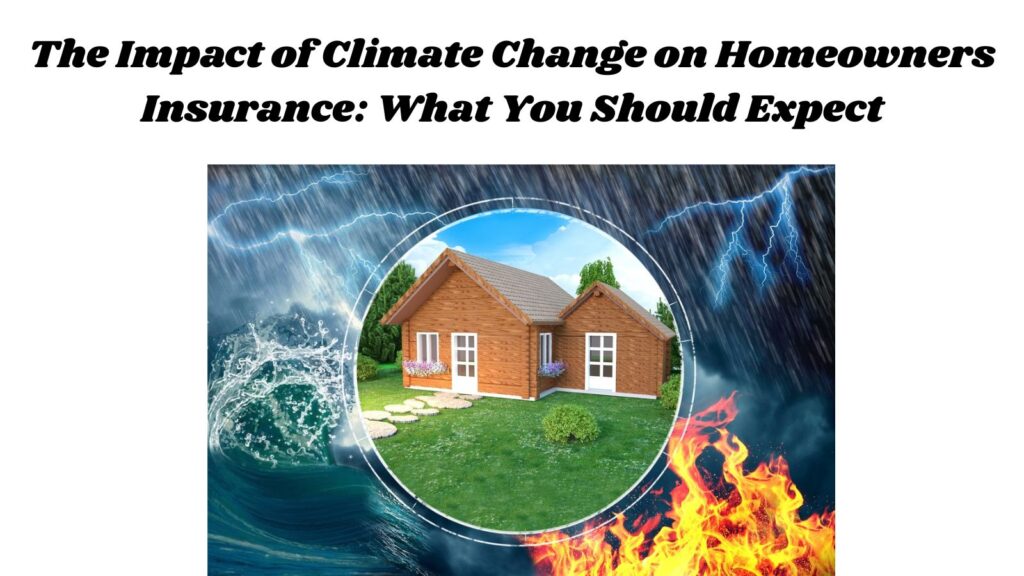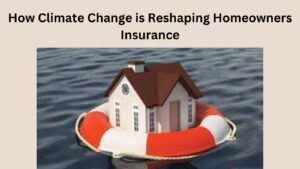Homeowners have faced more challenges from climate change lately. Natural disasters are happening more often and are more severe. Hurricanes, floods, wildfires, and heatwaves are happening more often and getting stronger. This puts homeowners at risk of major financial losses.
But what does this mean for homeowners insurance? How are insurance companies changing their policies and premiums because of these environmental changes? How can homeowners protect their properties today? Climate-related risks are a big concern.

This article looks at how climate change affects homeowners insurance. We’ll discuss changes in your premiums and steps to protect your home and finances.
The Link Between Climate Change and Natural Disasters
Contents
- 0.1 The Link Between Climate Change and Natural Disasters
- 0.2 How Climate Change is Affecting Homeowners Insurance
- 0.3 What Homeowners Can Do to Protect Their Homes and Finances
- 0.4 Conclusion: Navigating the Future of Homeowners Insurance
- 0.5 How to Build a Comprehensive Insurance Plan for Your Family’s Future
- 1 Frequently Asked Questions
- 1.1 Why are homeowners insurance premiums rising due to climate change?
- 1.2 Does homeowners insurance cover damage from floods or wildfires?
- 1.3 Can homeowners lower their insurance premiums by making their homes more disaster-resistant?
- 1.4 What should I do if my homeowners insurance is canceled due to climate-related risks?
- 1.5 How often should I review my homeowners insurance policy?
Before we explore how climate change impacts homeowners insurance, let’s look at how it connects to natural disasters. The National Oceanic and Atmospheric Administration (NOAA) states that climate change has increased how often and how severely some natural disasters occur:
- Hurricanes: Warmer oceans make hurricanes stronger and more intense. This causes more storm surge, flooding, and wind damage.
- Wildfires: Higher temperatures, extended droughts, and changing rain patterns have caused more wildfires. This is especially true in the western United States.
- Flooding: Rising sea levels, more rain, and frequent storms cause severe flooding. This affects millions of homeowners each year.
- Heatwaves: Long periods of extreme heat can harm homes and increase wildfire risks. They also pose health threats to people living in affected areas.
The Intergovernmental Panel on Climate Change (IPCC) expects extreme weather events to get worse in the coming decades. This could disrupt the housing market and homeowner insurance even more.
How Climate Change is Affecting Homeowners Insurance
Natural disasters are happening more often and with greater intensity. This trend is affecting homeowners insurance policies directly. Insurance companies are now adjusting their strategies and pricing models to account for these new risks. Here’s how climate change is influencing homeowners insurance:
1. Rising Premiums
One of the most noticeable effects of climate change on homeowners insurance is the rising premiums. Insurance companies are paying more claims because natural disasters are getting worse. So, they are raising premiums for homeowners to cover these costs.
Homeowners in disaster-prone areas, such as coastlines and wildfire zones, are seeing higher premiums, according to the Insurance Information Institute (III). Homeowners in Florida face a constant threat from hurricanes. Because of this, their insurance premiums have gone up by 30-50% in recent years. In California, places with high wildfire risks are seeing big jumps in insurance costs.
2. Changes in Coverage
Natural disasters are happening more often and getting worse. Because of this, some homeowners see that their current policies don’t cover certain types of damage well enough. For instance, many standard homeowners policies do not cover flooding or wildfire damage. In areas prone to these risks, homeowners may need to purchase additional coverage.
In flood-prone areas, homeowners might need to buy a National Flood Insurance Program (NFIP) policy. They can also get a private flood insurance policy if their property is at risk. In wildfire-prone areas, homeowners might need extra coverage for fire damage. They may discover that their current policies don’t provide enough protection.
3. Policy Cancellations and Non-Renewals
In high-risk areas, some insurance companies cancel or refuse to renew homeowners’ policies. This trend is particularly common in areas affected by wildfires, hurricanes, and floods. The California Department of Insurance reported that from 2015 to 2020, more than 100,000 homeowners in California couldn’t get homeowners insurance due to wildfire risks.
Real-Time Example: In Paradise, California, the 2018 Camp Fire caused severe damage. It destroyed over 18,000 structures. Afterward, many homeowners saw their insurance premiums rise sharply. Some even had their policies canceled entirely. Insurance companies pulled out of the market due to high wildfire risks. This left many residents struggling to find affordable coverage.
What Homeowners Can Do to Protect Their Homes and Finances
Climate change greatly affects homeowners insurance. However, homeowners can take steps to reduce risks and safeguard their properties. Here are some strategies:
1. Fortify Your Home Against Natural Disasters
A great way to protect your home is to make it stronger against climate risks. This can also help lower your insurance costs. This can include:
- Hurricane-Proofing:
- Install impact-resistant windows and doors.
- Reinforce your roof.
- Secure outdoor objects to prevent them from becoming projectiles in a hurricane.
- Flood-Proofing: Raise your home above flood levels. Install sump pumps, and use water-resistant materials in areas at risk of flooding.
- Wildfire-Proofing: Make your home safer by creating a defensible space. Clear dry plants, use fire-resistant roofing, and add ember-resistant vents.
These measures can help reduce the risk of damage and make your home more appealing to insurers.
2. Consider Bundling Your Insurance Policies
Many insurers offer discounts if you bundle multiple policies, such as homeowners and auto insurance. Consolidating your coverage with one provider may help reduce your premiums, even in high-risk climate areas.
3. Review and Update Your Policy Regularly
Review your homeowners insurance policy often. Climate change is increasing natural disasters, both in frequency and severity. Check that your coverage limits are enough. This is important if you’ve improved your home or if your area has seen recent environmental changes.
For example, after a major flood, you might need to increase your flood insurance coverage. Or, after a wildfire season, you might need to add more fire insurance to your policy.
4. Shop Around for Insurance
With climate change affecting homeowners insurance in many areas, it’s important to shop around for the best rates and coverage. Insurance companies assess risk in different ways. So, comparing quotes from several providers can help you find the best deal for your home.
5. Explore Government Assistance and Grants
In high-risk areas, government programs provide money or subsidies. This help allows homeowners to protect their properties. Some states offer tax breaks for homeowners who improve their homes to withstand disasters.
The relationship between climate change and homeowners insurance is an evolving issue. Natural disasters are happening more often and with more force. Homeowners might face higher premiums. They may also see changes in coverage. In high-risk areas, getting insurance could be harder. Homeowners can lower risks and protect their money by knowing how climate change affects their insurance. Taking proactive steps can help safeguard their homes.
Whether it’s reinforcing your property, reviewing your insurance coverage, or shopping around for the best rates, the time to act is now. Climate change brings new challenges. With smart planning and preparation, homeowners can protect their homes and secure their finances.
How to Build a Comprehensive Insurance Plan for Your Family’s Future
Frequently Asked Questions
Homeowners insurance premiums are going up. This rise is due to climate change. It has caused more natural disasters, which are more severe. As a result, insurers face higher claims costs. As a result, insurers are passing these costs onto homeowners in the form of higher premiums.
Does homeowners insurance cover damage from floods or wildfires?
Standard homeowners insurance policies typically do not cover damage from floods or wildfires. Homeowners in high-risk areas might need extra coverage. This includes flood insurance or wildfire protection. Such policies help ensure they have enough protection.
Yes, you can protect your home from natural disasters. For example, install impact-resistant windows or elevate your home in flood-prone areas. These steps can lower the risk of damage and might help reduce your insurance costs.
If your insurance is canceled, start by shopping around for other providers. Check for state-run insurance programs or government assistance in your area. These can help you get coverage.
How often should I review my homeowners insurance policy?
It’s a good idea to check your homeowners insurance every year. You should also review it after big changes, like home renovations, local disasters, or changes in your home’s value.
In summary, the impact of climate change on homeowners’ insurance is a growing concern. Knowing how climate risks impact insurance costs and coverage can help homeowners. This understanding helps them make smart choices. It also protects their homes in an unpredictable world. Homeowners can take proactive steps to tackle these challenges. This helps ensure long-term security for their families and properties.
